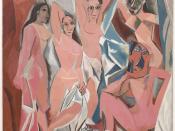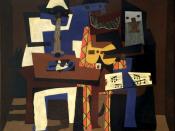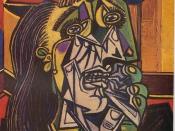piet mondrian
georges braque
alexander calder
I.
FORMALISM.
Formalism first pops its head onto the scene with Georges Braque and Picasso. Working closely for some years, these two revolutionary artists draw away from Impressionism and create a new movement known as Cubism. Here modern art leaps away from content and into formalism, a new concept many new artists toy with. With Braque and Picasso at the reins, Cubism becomes very popular. New artists toy with these formalist concepts, from Analytic Cubism to Synthetic Cubism. While Picasso is the more household name these days, history book rarely remember the part played by Georges Braque in the creation of Cubism. If we look at the two pieces compared in the text (p. 1076, Violin and Palette and Ma Jolie) we see the influence Picasso and Braque had on each other's art.
In Picasso's Ma Jolie we see the formalist theories already forming.
Here the point of departure is predictable only by the title and a musical clef in the bottom left corner. Instead of focusing on the woman the painting is said to be of, Picasso veers off into a color, line, shape study. A monochromatic work, Picasso aims to paint the essence of his point of departure, rather than the literal image.
Around the end of Cubism, Piet Mondrian also latches on to the formalist theories of form as content. Beginning by studying Cubism, Mondrian went his own way and founded a new movement, one called De Stijl of Dutch origin. Instead of the fractured style of Cubism, he sought to capture beauty in its most simple essence. The shape and color, the balance of beauty. He began experimenting with this theory to capture the essence of beauty in his work. Composition with Yellow, Red, and Blue is a perfect example...


